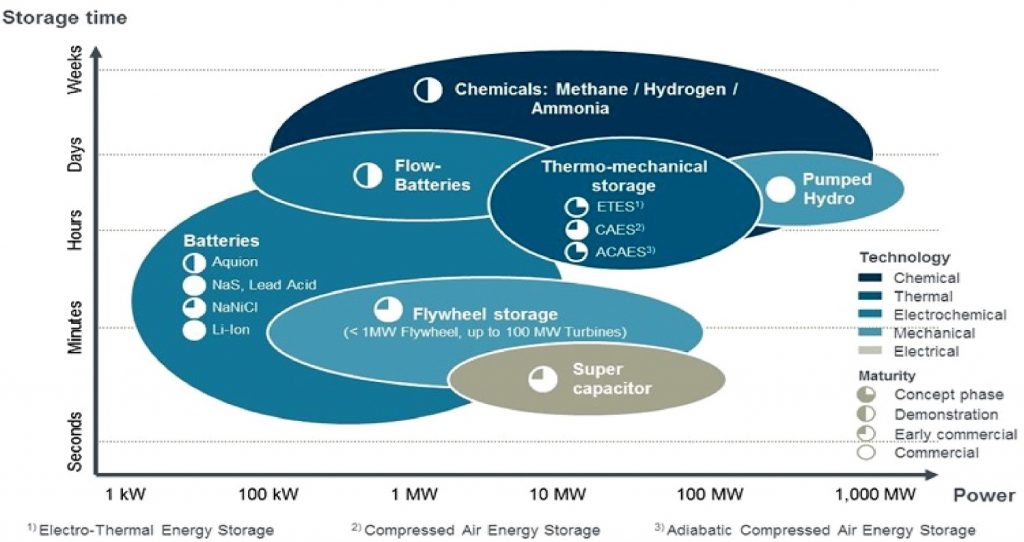Continued from Part 1
At present, there is a range of existing mechanical, chemical, thermal, and electrical technologies for storing electrical energy adaptable from small to large scale applications. Of all these technologies, only Compressed Air Energy Storage (CAES), Pump Hydro and Chemical Energy Storage systems have enough commercial maturity and the ability to store energy for large scale applications over long periods of time. The first two suffer the limitation of site placement due to their geographic/geological requirements. Thus, chemical storage via hydrogen and/or derivatives (such as ammonia) and hydrocarbons present a viable option for practical energy storage in the near term. Bearing in mind a desire to reduce carbon emissions then only hydrogen and ammonia remain as candidates to drive the storage of large quantities of energy with flexible relocation of resources with a reduction in CO2 emissions. Finally, movement and storage of hydrogen have proved to be more complex than for ammonia, for which a fully developed infrastructure has existed over a century, thus positioning ammonia as a strong candidate to support the concept of flexible energy storage at the largest scale.
A comparison between different storage technologies (Courtesy of Dr. Ian Wilkinson, Siemens.) is shown in the thumbnail.
Ammonia has recently started to receive attention internationally as a consequence of the primary benefits, for example, Japan has been looking for renewable alternatives for its energy consumption requirements over the last few decades, due to a lack of natural energy resources. Hydrogen has been presented as an attractive solution that could meet their energy demands, accompanied by a reduction in greenhouse gas emissions. However, Japan has clearly recognized the potential of ammonia to serve as the hydrogen carrying energy vector, and a 22-member consortium led by Tokyo Gas has been created to curate “Green Ammonia” promoted by the Cross-Ministerial Strategic Innovation Program (SIP) of Japan, seeking to demonstrate hydrogen, ammonia, and hydrides as building blocks of a hydrogen economy. The Japan Science and Technology Agency (JST) has announced the intentions of the consortium to develop a strategy for “forming an ammonia value chain” that promotes the leadership of the country in the production and use of the chemical worldwide. All consortium members have extensive knowledge of handling ammonia, with multimillion projects in progress or under consideration. For example, IHI Corporation and Tohoku University plan to invest $8.8 M in 2017 to set up a dual-fuel gas turbine that co-fires one part of ammonia to five parts of methane; similarly, Chugoku Electric Power Company intends to conduct co-firing experiments with coal and ammonia (at 0.6{828d3c3f61672f5f3f915e8276d5ef35c5e0117d26b89f98a9d5e22a85a2eb78}) at one of their power plants, paying $373,000 for the implementation of this project.
Oxford University recently published an extended report entitled “Analysis of Islanded Ammonia-Based Energy Storage Systems”. The work assessed different technologies available in the market and the potential economic implications of recovering stranded energy in various sites, i.e. islanded and non-islanded, through the use of ammonia. The results demonstrated that ammonia is economically viable for island regions where both ammonia for energy storage and fertilizer are combined. Although the current market is small and further development on the synthesis of carbon-free ammonia is needed for further expansion, the proposal shows that under the current scenario the use of ammonia for these means is feasible. Special emphasis on this point needs to be given to those small islands around the UK or other island nations where such systems can successfully and economically be deployed. Politics have also a role to play in the use of ammonia, which has found support from Parliament in the form of Lord Howell of Guildford, who recently wrote in ‘ JPN Times’ that ammonia will be a “revolutionary disruption coming to the energy sector,” and suggests that using ammonia for energy storage will prove to be “a game-changer at least on the scale of the shale oil and gas revolution.”
Lord Howell of Guildford served as Secretary of State for Energy and for Transport during his thirty years as a British Member of Parliament, and he is now chairman of the House of Lords International Relations Committee.


